Peperomia caperata ‘Rosso’ is a true compact star.
No literally… with gorgeous lance-shaped leaves radiating from the center, it really looks like our very own plant celestial body (or a ninja star, I can’t decide what I prefer).
As a tropical semi-succulent, this Peperomia is a super versatile species.
Able to be grown easily as a houseplant, its compact nature and love of humidity also puts it as a great beginner terrarium plant – as long as you’re careful with the watering.
Ready to get into the finer points?
Let’s go.
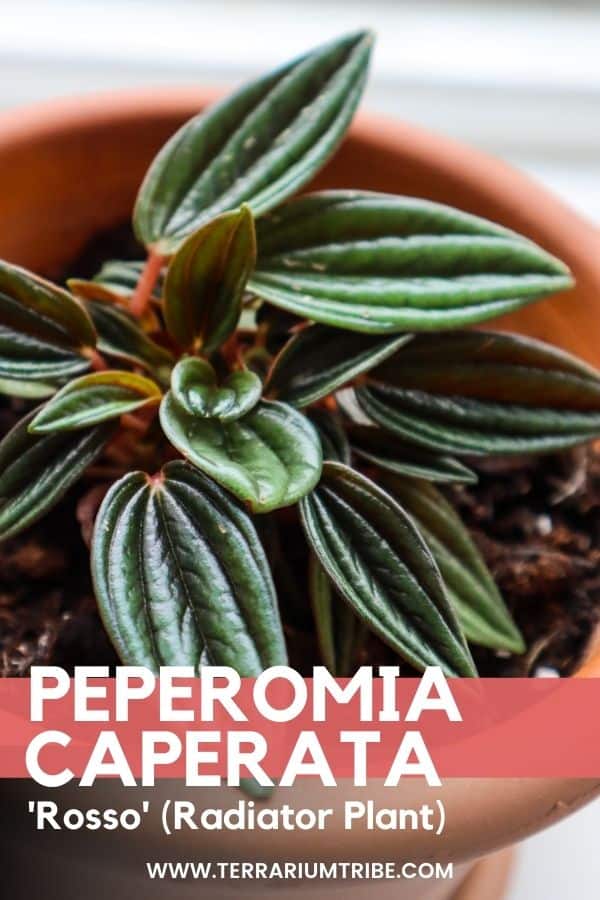
Peperomia caperata ‘Rosso’ 101 (Emerald Ripple Peperomia)
This tropical Peperomia is a real decadent beauty.
The dark emerald green leaves often have a chocolaty hue to them, which is contrasted wonderfully by the crimson undersides and stems.
The name ‘Rosso’ is a great fit (meaning “red” in Italian, of course).
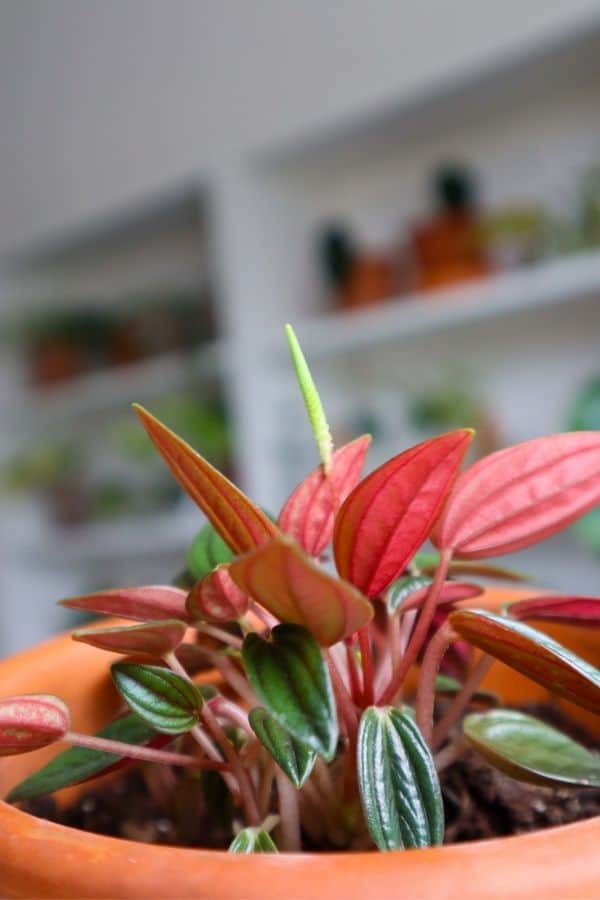
According to its patent, the full name of the variety is actually “Eden Rosso,” and it’s a hybrid of Peperomia metallica and Peperomia marmorata.
Though its current scientific name “caperata“ actually comes from the Latin word for “wrinkled,” – alluding to the deeply ridged foliage of this plant. Which also leads to the common name, the Emerald Ripple Peperomia.
But enough about names!
Let’s get onto how to grow these beautiful plants.
Where to Buy Peperomia Rosso
See the links below to purchase from reputable terrarium plant shops and marketplaces (may include affiliate links).
Peperomia Rosso Care & Growth
At a Glance
| Plant Type | Foliage, small |
| Lighting | Bright indirect light |
| Temperature | 65-77°F (18-25°C) |
| Watering | Light, even moisture |
| Humidity | Medium to high (50-80%) |
| Growth | 5-8 inches |
Lighting
Despite its succulent nature, Peperomia Rosso better fits the profile of a tropical plant.
Meaning, it’s best suited to bright indirect light. The kind of indirect sunlight that Peperomia might experience on the rainforest floor or in the trees/fallen logs (as they’re often epiphytic in the wild).
Direct sunlight is likely to be too harsh, so you’re better off having this plant a few feet from a light source or, ideally in a bright spot by a Northern windowsill.
Under bright light, it’ll give you the richest colours and brightest flowers.
Though – unlike many other plants – brighter light tends to keep this Peperomia more compact rather than encouraging growth. Which is part of what makes this plant such a great fit for terrariums.
On the flip side, despite handling low light conditions pretty well, it can end up with a leggy plant – so fluorescent lighting can help here to keep your plant healthy and full (we employ a grow light in the Winter seasons).
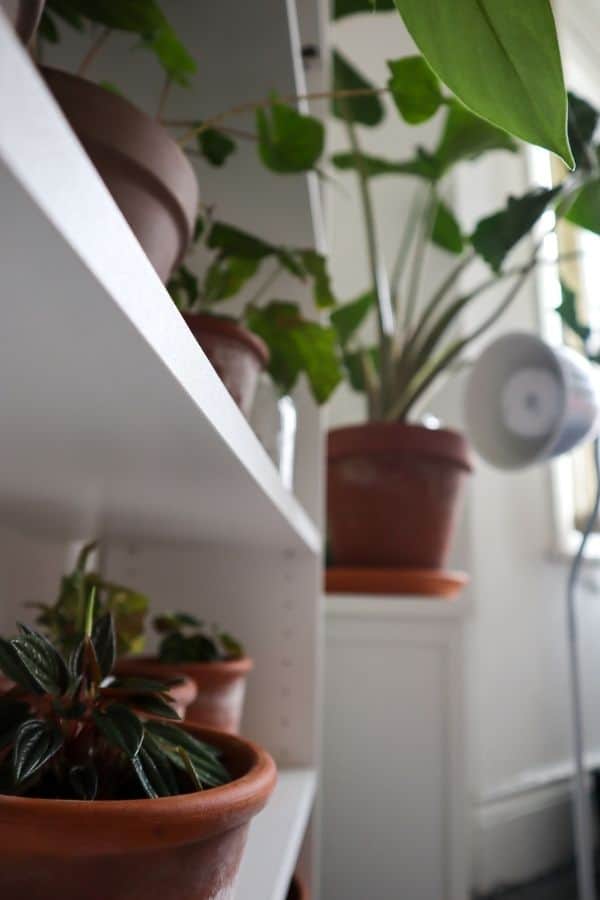
Watering
Here’s the important part when it comes to caring for Peperomia Rosso.
There’s a fine balance to be found between keeping both the tropical and succulent aspects of this plant happy.
The key is to provide consistent light moisture.
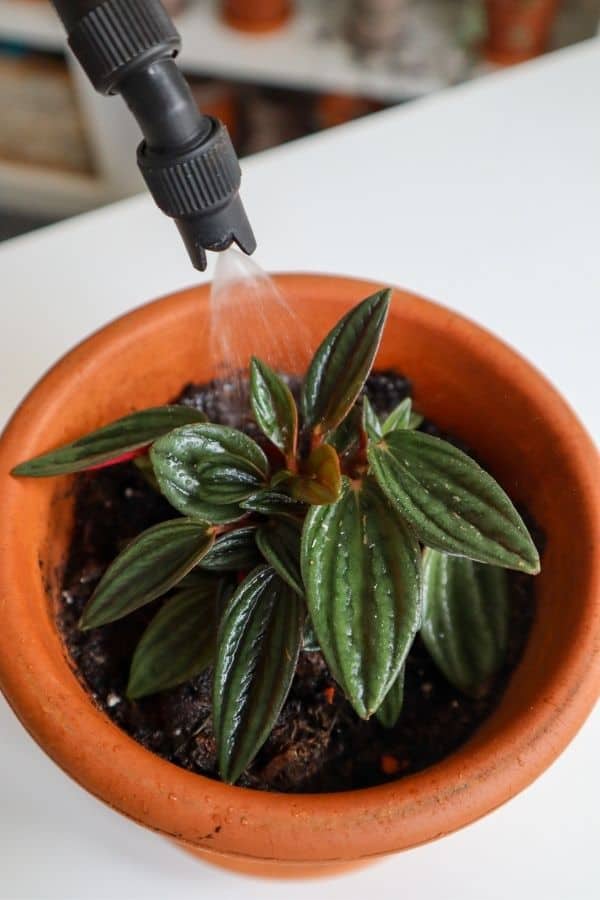
Enough so that the plant never goes dry, but is never sat in soggy soil either. After all, as an epiphyte, this species is not accustomed to sitting in moisture, so it’s very susceptible to root rot.
- As a potted plant, this is easily achieved by simply having a drainage hole. That way, you can thoroughly water this tropical plant without running the risk of water-logging it because there’s somewhere for the excess water to drain.
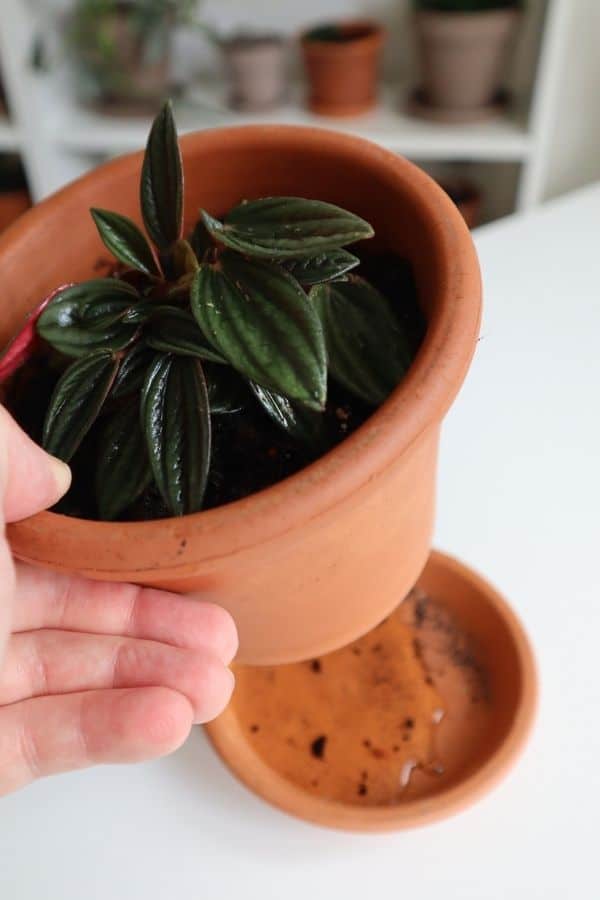
- In a terrarium, you’ll need to be more careful with how much water you add. Adding just a little at a time to preserve a minimal water balance. That being said, the high humidity of a closed terrarium can help to offset some of its water requirements.
Substrate / Soil
As an epiphytic species, Peperomia has quite shallow roots.
This means they won’t be able to reach moisture that’s deep in the pot. So, you’ll need a substrate that retains plenty of moisture that can be freely accessed.
Conversely, it needs excellent drainage and root aeration.
I like to use a typical tropical mix, using coco coir as a base for good water retention and supplementing with plenty of orchid bark and perlite or pumice for aeration and drainage. This holds up perfectly in a terrarium, too.
That being said, if you’re a succulent fan and already have some cacti/succulent potting mix to hand – you could probably get away with it if you were to add some coco coir to the blend.
Temperature & Humidity
Being of tropical origins, Peperomia Rosso thrives in warm temperatures and humid conditions.
Though, I find it’s very forgiving and isn’t going to complain if you’re providing these at the lower ranges. Typical household conditions are usually just fine.
Anything from 65-77°F (18-25°C) and 50-80% humidity will work a treat.
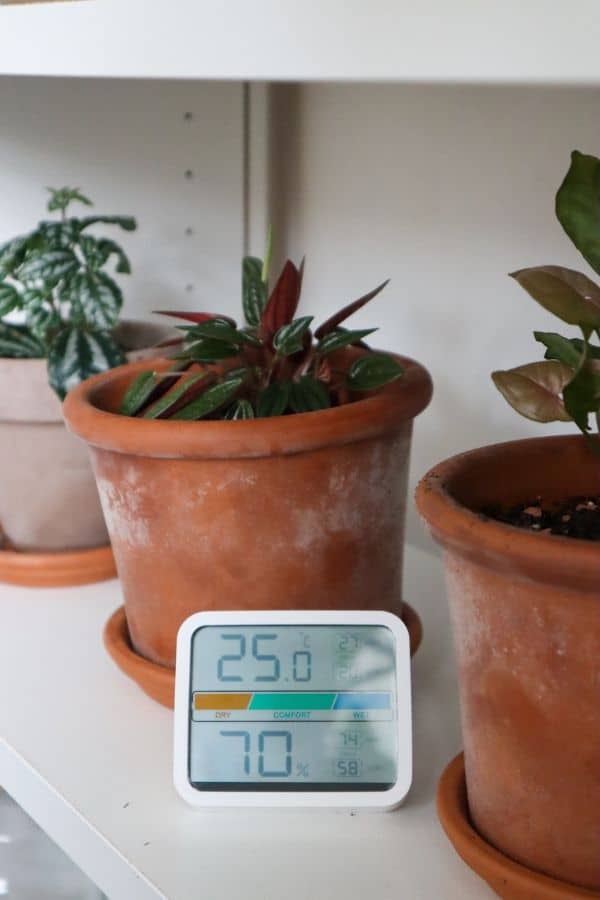
They can start to suffer if exposed to cold temperatures and drafts, so if you’re feeling a chill you can be sure your plant is too.
Growth
When it comes to growth… well, you can’t expect much of it – that’s kind of the point!
This is by no means a fast-growing plant, and it stays pretty compact, even when it’s healthy and thriving. They even like to be a little pot-bound, so you generally won’t be re-potting this one (yet another reason they’re well suited to terrarium life).
They can eventually spread to 8 inches or so, but that’s about it. Honestly, I rarely fertilize my plant beyond a tiny bit of balanced liquid fertilizer in the growing seasons.
You can expect a little leaf drop from time to time, especially in Winter.
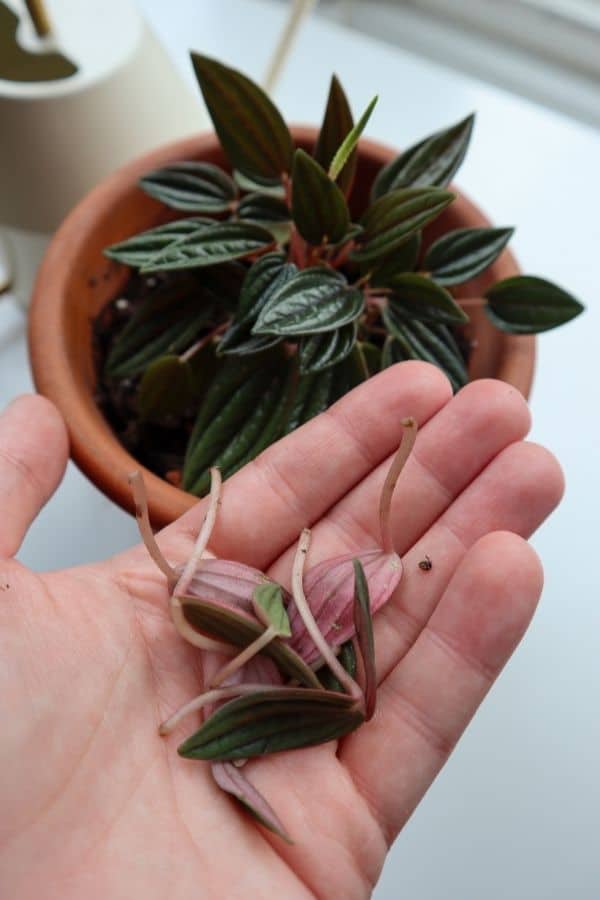
There are no true flowers to speak of, but they will readily produce bright floral spikes in the Spring and Summer months (mine’s in lime green but they can display a variety of colors).
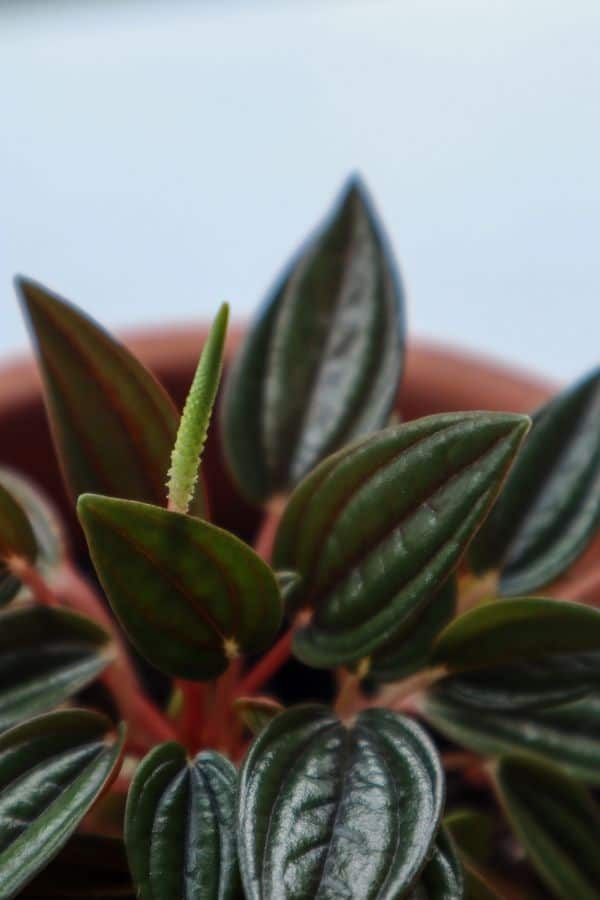
Propagation
Peperomia are famed for their easy propagation processes.
There are very few types of plants that will readily propagate from both leaf and stem cuttings.
Stem cutting:
Stem cuttings are best propagated in water.
- Simply take a cutting from the longest healthy stem that you can find (it’s harder to submerge short ones later). There’s no nodes as such, so just snip as close to the crown as you can.
- Pop that bad boy in water and wait!
Leaf cutting:
Leaf cuttings are a little different, and need to be propagated in soil instead. Though I’m generally a big fan of water propagation, in this case I think this is the easier option.
- Pinch (or cut) off a healthy mature leaf where it meets the stem.
- Dip the freshly cut end in rooting hormone and gently plant them stem down into some fresh substrate. You’ll likely have to do some manual adjustments to prop them up, but it’s okay to bury them a little.
- Water them thoroughly and ideally put them somewhere warm and humid (i.e. a terrarium of sorts).
The patent quotes around 21 days to see some root development, but that’s probably under strong grow lights, so yours may take longer.
Varieties & Similar Plants
There are so many amazing Peperomia species, and practically all of them make excellent terrarium plants. Anything under the “Radiator Plant” umbrella is usually a good fit.
Peperomia ‘Piccolo Banda’ is a similar compact plant but with round leaves. Or if you want something a bit bigger then check out something like the Raindrop Peperomia.
And don’t forget all the great vining species: Peperomia prostrata (String of Turtles), Peperomia Hope, Peperomia Pepperspot, or Peperomia rotundifolia.
Alternatively, how about the crimson Bloodleaf Plant?
Frequently Asked Questions
There’s very little to be gained by misting Peperomia Rosso as the boost in humidity is very brief. You’d do better by boosting the humidity of the room or using a pebble tray.
Peperomia Rosso is a vigorous flowerer, often producing tall floral spikes in a variety of colours.
Peperomia Rosso is a succulent, however it’s of tropical origins and therefore doesn’t fit your typical succulent needs. Unlike regular succulents, this Peperomia likes consistent moisture and high humidity.
Peperomia Rosso is a versatile plant that thrives indoors and in terrariums.
Peperomia Rosso is a non-toxic plant, so you can rest assured that the little animals and people in your life won’t harm themselves with this species.
